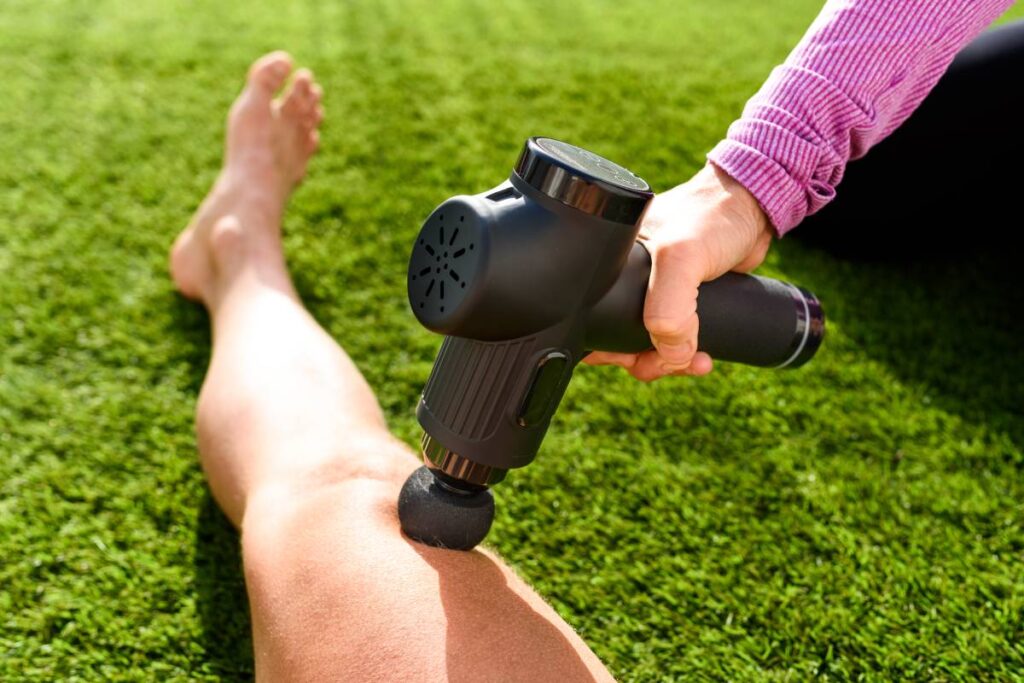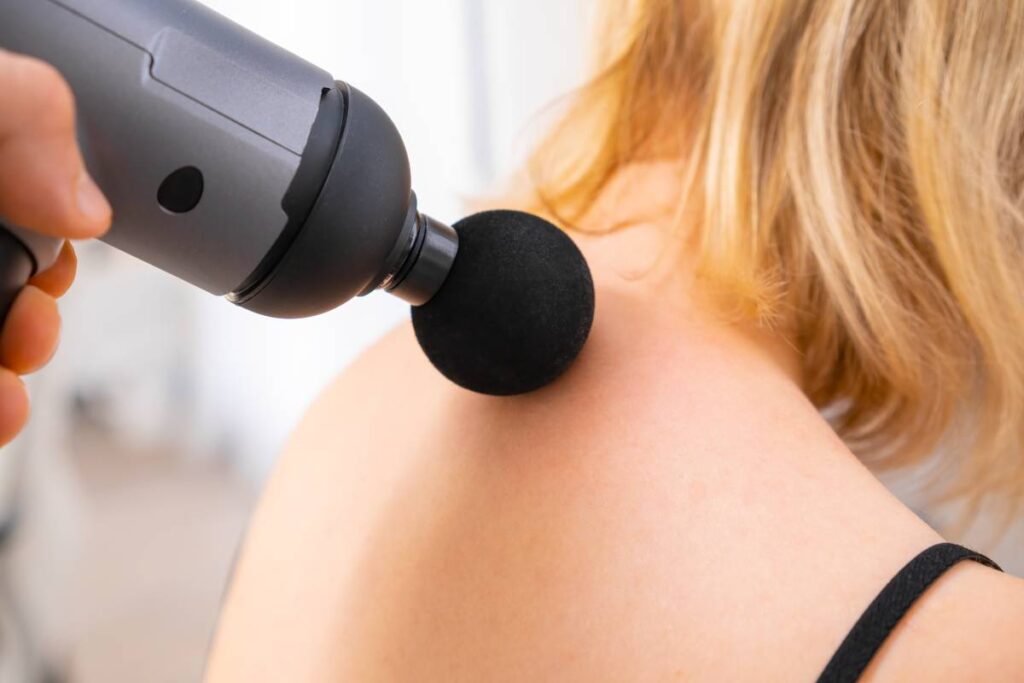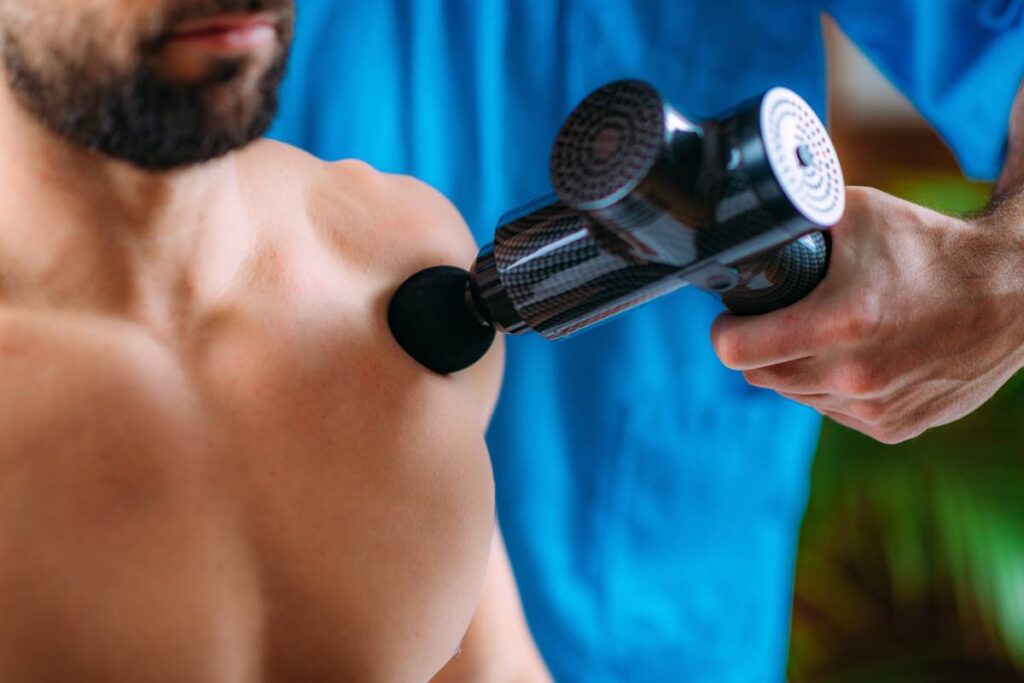Embarking on the quest for relief from muscle tension and back pain, the rise of massage guns has captured our attention. These handheld devices promise a quick remedy, employing percussive therapy to tackle soreness and discomfort.
But before we dive into the world of vibrating wonders, let’s explore the science, expectations, and precautions associated with these gadgets. Are massage guns truly the magic wand for our aches and pains?
Do massage guns really work?
In recent years, the buzz surrounding massage guns has been hard to ignore. These handheld devices claim to offer a quick and effective solution to muscle tension and soreness. But the big question remains: do massage guns really work? Let’s dive into the science behind these gadgets and explore whether they live up to the hype.
Understanding the Mechanism:
Massage guns operate on the principle of percussive therapy, delivering rapid pulses of pressure to targeted muscle areas. This rhythmic pounding aims to stimulate blood flow, break up knots, and relieve tension. The percussive action is thought to enhance circulation, reduce inflammation, and promote muscle recovery.
Scientific Support:
While the concept may sound promising, scientific evidence supporting the effectiveness of massage guns is still evolving. Some studies suggest that percussive therapy can potentially improve muscle function and alleviate soreness, especially after intense physical activity. However, more research is needed to establish conclusive evidence regarding the long-term benefits and overall effectiveness.

Immediate Relief vs. Long-Term Impact:
Users often report feeling immediate relief after using massage guns. The percussive massage can create a soothing sensation and may temporarily reduce muscle tightness. However, it’s essential to distinguish between short-term comfort and long-term impact. The question arises: do massage guns provide lasting benefits, or are they merely a quick fix?
Complementary Approach to Recovery:
Massage guns are not a one-size-fits-all solution, and their effectiveness may vary from person to person. It’s crucial to view them as a complementary tool rather than a standalone remedy. Incorporating massage gun therapy into a broader recovery routine, which includes proper hydration, nutrition, and rest, may yield more comprehensive results.
User Experience and Preferences:
One significant factor in assessing the effectiveness of massage guns is individual preference. Some people find these devices to be valuable additions to their recovery toolkit, while others may not experience the same level of benefit. Factors such as the intensity of the massage, frequency of use, and the specific area targeted can all influence the user experience.
Potential Risks and Considerations:
While massage guns are generally considered safe for most people, it’s essential to use them responsibly. Applying excessive pressure or using the device on certain body areas may lead to discomfort or injury. Individuals with certain medical conditions, such as muscle strains or injuries, should consult with a healthcare professional before incorporating massage guns into their routine.

Is massage gun good for back pain?
The relentless ache in your back – a common woe for many. Enter the massage gun, a device that promises to zap away those persistent knots and discomfort. But the burning question remains: is a massage gun a reliable ally in the battle against back pain? Let’s explore whether this nifty gadget lives up to its claim and could be the remedy you’ve been searching for.
Before diving into the world of massage guns, it’s essential to grasp the basics of back pain. This discomfort can stem from various factors, including muscle tension, poor posture, or even stress. The idea behind using a massage gun for back pain is to address these issues by targeting muscle knots and promoting blood flow.
Massage guns operate on the principle of percussive therapy, where they deliver rapid pulses to the muscles. This rhythmic pounding is designed to stimulate circulation, relax tight muscles, and potentially provide relief from pain. The percussive action is believed to break up knots, release tension, and encourage the body’s natural healing processes.
Research on the efficacy of massage guns for back pain is still in its early stages, but initial findings are promising. Some studies suggest that percussive therapy can help alleviate muscle soreness and improve range of motion. While more extensive research is needed, the existing evidence hints at the potential benefits of using massage guns as part of a holistic approach to managing back pain.
A single, small observational study focused on individuals with fibromyalgia, a chronic condition marked by pervasive pain and discomfort. These participants underwent 10 sessions of deep, oscillation massages spanning five weeks. Upon completion of the study, every participant reported an improvement in their symptoms and noted an enhanced quality of life.
Not all massage guns are created equal, and selecting the right one for your needs is key. Consider factors like intensity levels, attachments, and ergonomic design. A massage gun that offers customizable settings allows you to tailor the experience to your comfort and the severity of your back pain.
While massage guns can be a valuable tool in your arsenal against back pain, they work best as part of a broader approach to pain management. Combining massage gun therapy with practices like stretching, maintaining good posture, and staying active can contribute to a more holistic solution.
Where should I not use a massage gun?
Massage guns have become popular tools for tackling muscle soreness and tension, offering a convenient way to promote relaxation and recovery. However, it’s crucial to be mindful of where these percussive devices are used. While they can be beneficial in many areas, certain precautions should be taken to ensure a safe and effective experience. Let’s explore the zones where you should exercise caution and avoid using a massage gun.
Bony Areas
Massage guns are designed to target muscles and soft tissues, not bones. Avoid using the device directly on bony prominences, such as the spine, joints, or areas with prominent bones close to the skin surface. The intense percussive action may cause discomfort or even lead to injury in these sensitive regions.
Injured or Inflamed Areas
If you have an existing injury or inflammation in a specific area, it’s wise to steer clear of using a massage gun directly on that site. The pulsating pressure may exacerbate the problem, causing more harm than good. Consult with a healthcare professional before applying percussive therapy to injured or inflamed regions.

Neck and Throat
The neck is a delicate and sensitive area, housing vital structures like the spine and major blood vessels. Using a massage gun directly on the neck can pose risks, including potential injury to the cervical spine or blood vessels. Exercise extreme caution or avoid the neck altogether, focusing on surrounding muscle groups instead.
Face and Head
The face and head are intricate regions with numerous nerves and sensitive structures. It’s advisable to avoid using a massage gun on your face or head, as the intense vibrations may lead to discomfort or unintended consequences. Stick to areas like the jawline or temples if you feel the need to address tension in these regions.
Abdomen
The abdomen houses vital organs, and using a massage gun directly on this area is generally not recommended. The percussive pressure may not provide significant benefits and could potentially cause discomfort or interfere with digestive functions. If you experience abdominal pain, it’s essential to consult a healthcare professional for guidance.
Pregnant Belly
For pregnant individuals, caution is warranted when using a massage gun on the abdomen, especially around the belly. The safety of percussive therapy during pregnancy is not well-established, and it’s advisable to seek guidance from a healthcare provider before incorporating a massage gun into your routine.
Varicose Veins
If you have varicose veins, using a massage gun directly over these areas may not be advisable. The intense pressure could potentially worsen the condition or lead to discomfort. Instead, focus on massaging surrounding muscle groups to avoid putting unnecessary strain on the affected veins.
Conclusion
In the realm of massage, the massage gun emerges as a potential ally against muscle tightness and back pain. Scientific evidence, though preliminary, hints at the positive impacts of percussive therapy. Yet, it’s crucial to approach these devices with a balanced perspective.
Whether seeking relief from back pain or targeting specific muscle groups, incorporating massage guns as part of a broader health and wellness routine holds promise. However, the key lies in understanding their limitations and using them responsibly. With realistic expectations and a mindful approach, massage guns can indeed become valuable tools in our journey towards a healthier, pain-free lifestyle.

